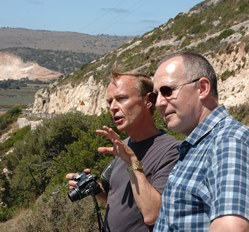“Οἵη περ φύλλων γενεὴ τοίη δὲ καὶ ἀνδρῶν*”

Hearing James Diggle, Professor of Latin and Greek at Cambridge, recite the first passage of Homer’s
Odyssey in the original, was one of the most memorable moments in my 20 years at Burlington House. He was introducing a London Lecture, by John Underhill in 2008, on what has become known as the ‘Bittlestone Theory’ (propounded in the 2005 book,
Odysseus Unbound) that the Paliki Peninsula (the westernmost tip of Kefalonia), was once an island itself, separated by a narrow marine channel that became infilled sometime after the late Bronze Age.
The theory had already caught my eye. My father was an enthusiast for things Attic, and even practised declaiming it as I lay in my cradle (reasoning that the voice was what mattered to an infant, not what it said). Later, he read to me from both Iliad and Odyssey (in translation!), and bought me books with titles like ‘Tales from Homer’; so when, in my teens, I finally read E V Rieu’s prose versions of these two founding documents of western culture, they were already very familiar.
Like most people, I just assumed that Ithaca was modern Ithaki, and in 1974 came across a collection of essays (by W B Stanford and J V Luce of Trinity College, Dublin) entitled The Quest for Ulysses, in which Professor Luce (rather flabbily) talked himself into the same conclusion, despite many discrepancies, while at the same time managing to praise Homer’s realism! This rang false. Like Luce, and Schliemann, I wanted to believe old Homer was an accurate topographer. His audience would have known their world; but if he had really meant Ithaki, crucial passages made no sense.
After reading Odysseus Unbound, 30 years later, I encouraged John Underhill to write about the project for Geoscientist, and several articles on the subject subsequently appeared - as well as a memorable day-trip in 2006, when John and Robert met me off the Zakynthos ferry, and showed me around (picture). Since then, much more research has been published – including a PhD thesis; and this month, John Underhill, our very own Peter Styles (who became involved subsequently on the geophysical side) and Greek colleagues bring us up to date.
Alas, Robert Bittlestone, the dynamic and brilliant inspiration behind it all, died in 2015, tragically early. However, Odysseus Unbound lives on. So far, geological evidence has done nothing but lend his exciting idea support. I am proud that this magazine has played a part in bringing it to wider notice, and delighted that this update should appear in my penultimate issue as Editor.
DR TED NIELD NUJ FGS, EDITOR
Ted Nield, @TedNield @geoscientistmag
* “As the lineage of the leaves so too is that of man." Homer. Iliad VI, 146